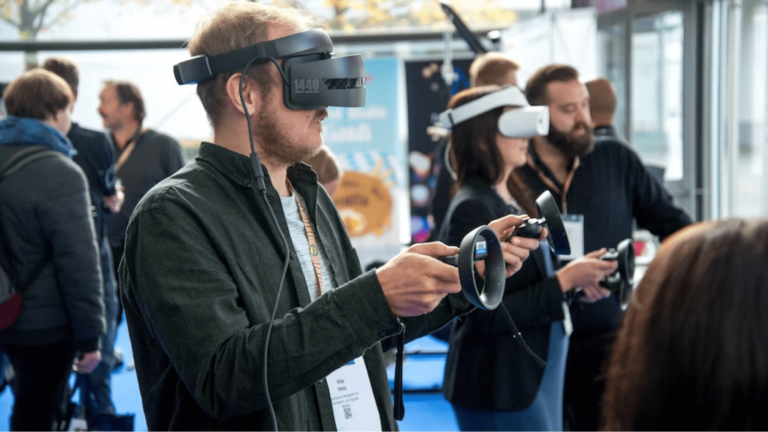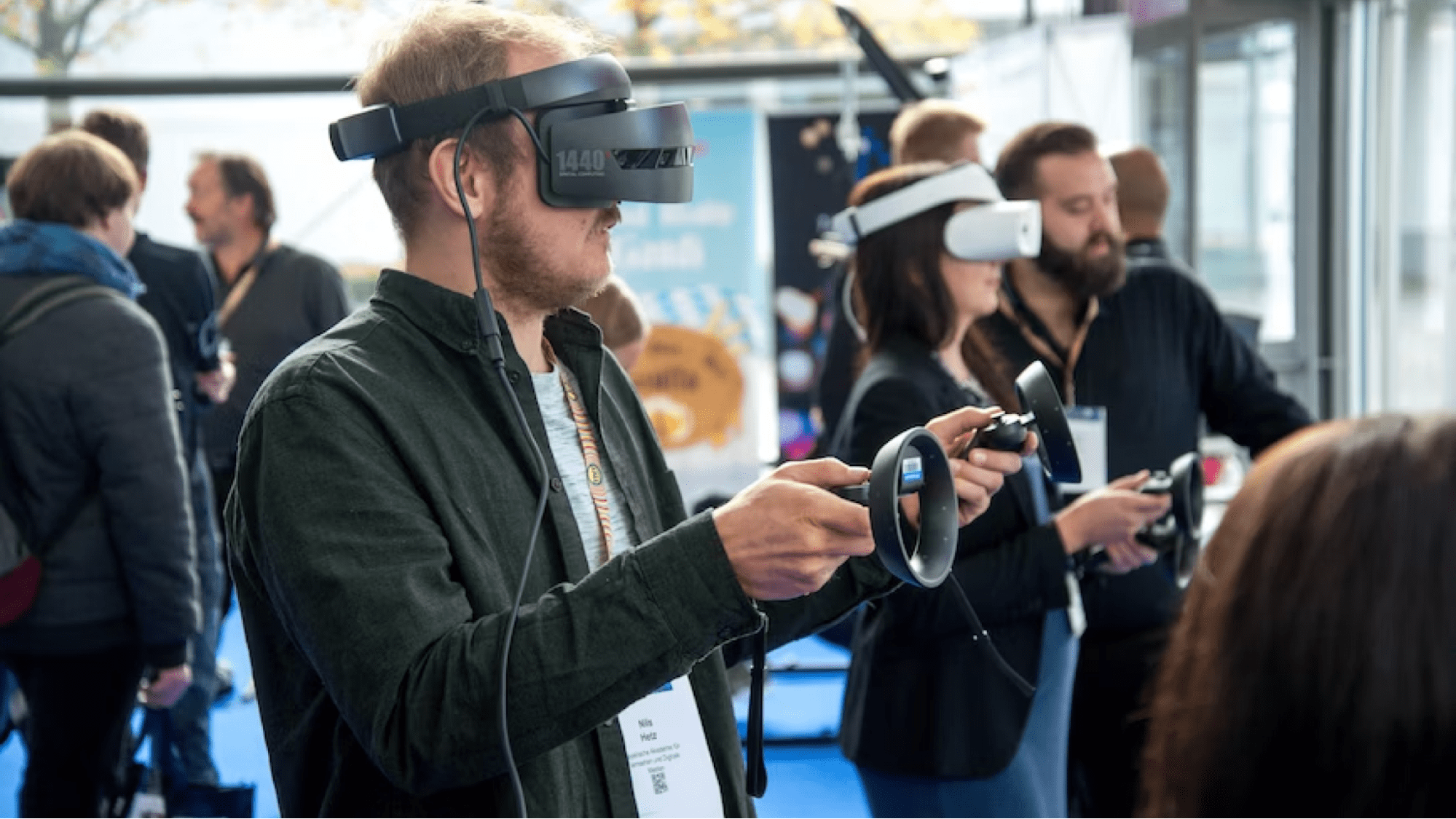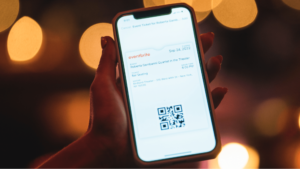Event technology has been a game changer, revolutionizing the way we plan, execute, and experience events. Staying ahead in the game can streamline processes, drive innovation, and foster the creation of immersive experiences that boost attendee engagement and event success.
You might be wondering what we’re talking about — event technology can be any type of digital tool, app, platform, or software that supports you in planning, creating, or operating a successful event.
Here at Eventbrite, we’re proud to be a part of this new era in event technology. Through our expansive digital network, artificial intelligence (AI) capabilities, and wide range of integrations with innovative apps and tech, we now support more than 800,000 event creators in staging unique experiences all over the world.
To help you make the most of event technology advancements we’ve created this guide where we focus on specific and useful event technology and how to use it, how to choose the right tech for your event, and 10 of the hottest trends in event technology in 2023.

What are the benefits of event technology?
Event technology benefits both event creators and attendees.
For event creators, event technology can make life so much easier. It saves you time selling tickets, onboarding clients or vendors, promoting your event, and analysing results through slick, streamlined automations.
By enabling you to manage your event marketing online, event technology such as specialised marketing tools can also help you increase engagement rates with potential attendees — converting social media followers or web users into bonafide ticket holders.
Event technology also allows you to measure critical aspects of your event to help you better understand your events through access to valuable data, like ticket holder- and attendee information. With this data, you can adapt your event planning and marketing strategies in real-time and after the event.
For attendees, event technology can enrich user experiences. Services like digital ticketing, online carts, event apps, and live chat functionality remove a lot of friction from user journeys. Less friction makes happier customers — and happy customers are more likely to attend your next event!

How to choose the right event technology
Creators can leverage a wide range of event tech tools — and some have more appropriate use cases than others. That’s why it’s critical to understand what you’re looking for when selecting a particular platform or app for your next event, be it a large-scale event or something more exclusive or community-focused.
Start by considering your event goals.
For example, if your goals center around generating certain profit levels or ticket sales, you’ll want to use an events management platform that gives you access to data that can be dissected after your guests go home. If your goals are around improving attendee satisfaction, you might want to look at event apps that offer survey functionality.
You’ve also got to factor in your event type and your target audience. Do some market research to find out what kinds of platforms your target market is already using, and try to find a tool they’re likely to adopt.
For example, let’s say you’re creating an event for a retirement community. Research suggests 33% of those aged 65 and over aren’t using a smartphone — and so you wouldn’t want to invest in creating an event-specific app that a third of your guests won’t be able to access.
Looking for a bit more inspiration on how to find the perfect event technology for you? See how the Tribeca Film Festival used event tech to streamline ticket purchases, create a seamless check-in experience, and analyse their data to boost ticket sales.

10 event technology trends to skyrocket your events in 2023
Now that we’ve covered what event technology is and why it’s so useful for event creators let’s take a look at some of this year’s top tech trends.
It’s important to note these are just the tip of the iceberg — if you really want to leverage event technology to turbocharge your next big event, you should definitely give one of these a try.
1. AI offers customisation and convenience
Speaking of AI, it’s increasingly being used to analyse data and offer up personalised recommendations, which can include everything from which talks you should attend to a new band that really fits your music taste.
Event creators can use AI technology to interpret data from social media profiles, including LinkedIn and Facebook, to create bespoke suggestions for each event attendee.
For example, who they should meet, which presentation might be particularly useful for their line of work, or which speaker they’d really love to hear. If this all sounds a little techy, don’t despair — the quickest way to get up to speed is to use an event app with an AI plug-in like Grip.
AI is also a fantastic tool to increase convenience and streamline the event promotion process. If you’re keen to explore the future of AI, Eventbrite offers AI-powered tools you need to know about:
- Event pages: Creators can easily fill in an event title, location, and dates, and AI will automatically generate event descriptions, summaries, and event images in a matter of seconds. The event type, category, and sub-category will also automatically be filled in, making it even easier for people to discover their events on our marketplace.
- Email campaigns: AI-powered email writing can help creators stand out in attendees’ inboxes, get more clicks, and drive ticket sales.
- Social media ads: AI-powered ad copy helps creators write like pros, and create content faster, helping event creators save time and reach more people.
“We’re integrating AI-powered tools into our platform, inspired by how AI enables event creators to spend less time creating their event listings and more time doing what they love: hosting unique and unforgettable events,”
Ted Dworkin, Chief Product Officer at Eventbrite.
Streamline your event marketing with Eventbrite’s AI tools.


2. RFID makes things quicker
Radio-frequency identification (RFID) streamlines the attendee experience by replacing tickets and physical payments for in-person events.
RFID chips are small enough to fit inside attendee bracelets and badges and, since they’re scannable, they reduce queuing time. They can also be used for cashless payments onsite at events such as music gigs and food festivals, a great way to create a smooth and safe experience for attendees.
In addition to facilitating faster check-ins and cashless experiences, using RFID gives you access to real-time insights.
You’ll know if guests are checking in to see your opening act and which entrances aren’t being used — and can be alerted right away if there are any hiccups getting people through the doors. Plus, by using RFID technology for events, you can track the behaviour and movement of attendees for valuable insight into venue layout.
RFID chips can also help you to enhance experiences for VIPs or higher-tiered ticket holders. Upon scanning, you’ll instantly see each person’s ticketing status — which means you can quickly and efficiently guide them to where they should be and the services available to them.
Want to see how RFID works in practice? Take a look at how event creator SnowGlobe used RFID to take their festival to the next level.

3. Facial recognition enables contactless check-ins
Another trend in event management, facial recognition is already being used at a number of events, from trade shows and conferences to football matches and club nights.
It creates a “smart event,” which allows for automated, contactless check-ins, dramatically reducing waiting times and interactions between attendees and event staff. In addition to speeding things up, the software can read facial expressions and body language to predict the mood of attendees — taking feedback to a whole new level.
When facial recognition spots “micro-expressions” like smiles or frowns, it can tally those expressions in real-time so that organisers always have an idea of the general mood of their attendees — whether it’s on arrival, during various acts, or upon exiting.
Facial recognition also enhances personalisation by enabling you (or your tech) to greet visitors by name on arrival and direct them based on their ticket type. It also reduces the risk of fraud by detecting unauthorised resold tickets.
However, facial recognition technology comes with some privacy considerations — you are, after all, scanning and saving peoples’ faces. Make sure to include this information on your event registration page and give your attendees the opportunity to opt out if they prefer.

4. Chatbots demonstrate it’s good to talk
As people get used to asking Alexa and Siri to add milk to their shopping list or play their favourite album, we can expect to see digital assistants and chatbots powered by artificial intelligence (AI) popping up in the events industry, too.
There’s been a wave of demand for chatbots in recent years. Industry analysts expect the market for bots to grow by around 23% over the next seven years — and with their wide range of use cases across events, it’s not hard to see why.
Chatbots are being used at events such as virtual gigs and trade fairs to answer attendee questions and provide important information. By automating customer service, attendees receive a rapid response, and organisers can continue to focus on planning their event.
There are plenty of ways to get started, from using Google’s Dialogflow, which integrates a chatbot into a website or event app, to adding a customer service plug-in with Facebook Messenger.
If you’re planning to use chatbots, set them up to answer FAQs before and during your event. You can do this by integrating a bot within your event app, which should free up your time addressing the same simple guest questions over and over again.

5. Virtual reality makes presentations stand out
There’s been a lot of buzz around experiential events, and virtual reality (VR) certainly has the ability to transport attendees to a whole new world.
Virtual reality technology creates a 3D, computer-generated environment that makes users feel like they’re totally immersed in those virtual surroundings. VR has loads of applications, which is why the global VR industry is expected to grow by 13.8% per year between 2023 and 2030.
With that kind of market growth, the possibilities are seemingly limitless — with creators using VR for engaging presentations and to stand out among hundreds of exhibitors at trade fairs. Charities like UNICEF are also revolutionising fundraising by using VR tech to draw attention to their cause.
When it comes to virtual event trends, look out for platforms like Sansar that allow you to create a fully immersive digital world.
Sansar can host all sorts of events with avatars in real-time — whether it’s a music festival, meet-and-greet, or lecture series. Not only does it offer customisation options, including a multi-tiered ticketing system, but the stunning visuals and spatial audio mirror the in-person experience so that your attendees will feel like they’re in the same room.
You can even use VR applications prior to your event.
For example, you can create 360-degree tours of your event venue and circulate them to ticket holders beforehand (or upload them onto your event app) so your customers know exactly what to expect when they arrive.
However, virtual reality is only effective when you’ve got good tech, which comes at a price — so if you plan on using VR at your next event, you’ll need to budget accordingly.
You can deploy a range of VR apps to complement your event. But if you’re planning to do a demonstration or live VR experience, you’ll likely need to contract a specialist to help you set up and provide onsite support.

6. Augmented reality creates an immersive experience
Augmented reality (AR) is a mind-bending halfway point between reality and virtual reality. You’ll most commonly see AR applied through mobile apps that superimpose computer-generated images onto your screen — adding people or things to your reality in order to create a unique, augmented experience.
As a point of reference, think Pokémon GO or interactive FaceTime filters.
Just like VR, the augmented reality space is growing rapidly. Analysts expect the AR market to expand by more than 50% per year between now and 2030. Translation: Event creators will be absolutely spoiled for choice when it comes to AR options.
For example, you can plot pop-up presentations or workshops that event guests discover using their camera phones around your venue. Or, if you’re looking for audience engagement, you could set up a virtual AR photo booth with custom event filters and encourage followers to share on their social media channels.
If you’re looking for inspiration in terms of execution, look no further than Eventbrite creator CyberActivities, Inc. and their You Sleuth Augmented Reality Detective Experience. The self-guided event is a combination of the games Cluedo and Pokemon GO.

7. Livestreaming opens your event to new audiences
Many creators began embracing livestreaming for things like webinars, concerts, and even theatre productions to reach wider audiences while in-person events could not take place. Initially livestreaming was considered the lesser alternative to live events.
However, according to our 2023 Event Trends Report, many event creators in the UK (39%) and Ireland (40%) say they price virtual tickets at the same level as in-person, showing an increase in the perceived value of virtual events — not hosting virtual events means missing out on a potential revenue opportunity.
A livestreamed event needn’t be complicated — it’s just like any other event you might organise. The only difference is that you’ve got a camera and audio equipment set up to capture everything happening at your event in real-time. By streaming your footage live, you’re expanding your reach to guests from all over the world.
For example, take a look at how event creator Daybreaker turned lemons into lemonade when they had to scale back in-person dance parties. Instead, they started livestreaming daily dance events — and the results were astounding.
Use social media to your advantage when livestreaming an event. Post the details ahead of the day by inviting people to join Facebook Live events or equivalent — and then encourage attendees, volunteers, staff, and suppliers to share them on platforms like Twitter. You could also use paid ads to increase your social media reach.
Want to learn more? Check out our guide on livestreaming basics, and take a look at how you can livestream using Eventbrite’s integration with Zoom and Vimeo.
Want to explore our livestreaming capabilities? Check out our virtual events platform.


8. 5G keeps customers connected
In this day and age, very few events can afford to run without amazing WiFi.
Superfast broadband is necessary if your vendors or stallholders are using point-of-sale (POS) terminals, and a lot of your on-site equipment might need basic connectivity to get the job done. 5G is especially important at events where you might be using an app or website for table service. Plus, that increased speed will make other technologies such as livestreaming, VR, and AR smoother and quicker to implement.
If you’re using an event management app, you’ll also need a great internet signal to check in attendees or scan ticket QR codes
By investing in great onsite internet service, you’re also opening yourself up to better brand recognition. After all, your visitors are far more likely to engage with your event on social media if they’re plugged into free WiFi.
Want to learn more about engaging your audience on social? Check out this Essential Guide on social media.
To secure a good connection, look for local providers who know the area, understand the bandwidth and coverage radius you need, and make sure to ask about onsite installation and support. After all, you don’t want to invest in getting a broadband system set up in the middle of nowhere only to have it break down after the installation team leaves.

9. Hybrid events let guests have their cake and eat it, too
Although loads of us were excited when in-person events started to come back over the last couple of years, there’s no denying that virtual events have some key benefits, too.
That’s why many event creators are now opting for hybrid events that combine all the best elements of both virtual and in-person events. Hybrid events often include different aspects of a virtual event — like a livestream, chat room, or on-demand video content but offer the physical more human connection to those who can be there in-person. This creates one unique experience for two different audiences.
Not only do hybrid events open up your event to guests from all over the world, but they also expand your ability to book a stellar line-up. For example, it might be easier to convince a global expert to speak at your hybrid conference if they don’t have to travel halfway around the world to do it.
Want to learn more about how hybrid events work in practice? Eventbrite can help. Our integration with Zoom enables you to set up virtual conferences and livestreams alongside live, in-person events with ease.
And if you need some inspiration, take a look at event creator MicroK12 and their regional TechFest Education Conferences. These free events provide a range of opportunities for school administrators to learn and network in-person — but everything is also livestreamed online for those unable to make the trip.

10. Gamification keeps guests engaged
If you’re looking for a fun way to deploy event technology, it’s gamification you want.
Gamification is all about promoting engagement through competition — and events are perfectly suited to gamification. That’s part of the reason the gamification market is growing by more than 27% each year.
Gamification is also a great way to learn, so if you’re running a workshop or educational event, you can use a gamification app to increase your attendees’ engagement in what they’re learning and have them leave with some real, actionable skills.
The use cases here are almost endless.
For example, you could create an award for the virtual guest who logs into the most workshops. Alternatively, you could set up a points system to recognise your biggest chat room contributors with a leaderboard that’s being updated in real time. You could even set up a virtual scavenger hunt around your event venue or site.
The best way to gamify an event is to build it around a gamification app for events. You can even work various AR elements into your event gamification to bolster engagement and create a truly unique user experience.
Stay ahead of the curve
Technology for the events industry is continuously changing, providing new opportunities for event creators and attendees alike.
From well-loved staples like apps and project management tools to exciting new technologies like AI, it’s worth staying on top of how tech can enhance your event and keep attendees hooked.
If you’re looking to leverage and combine some of these trends, Eventbrite is where you want to be. Not only is our dynamic platform AI-enabled, but our wide range of integrations can support you with livestreaming, RFID, and everything in between.






